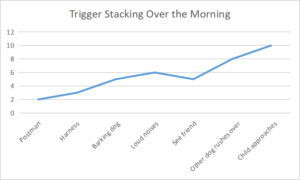Come on then, what is trigger stacking?
Trigger stacking is not specific to dogs. We all go through it and can usually relate well to it.
Firstly let’s quickly recap what a trigger is. A trigger is something that your dog finds stressful, that triggers an emotional reaction. When I say stressful, these things are not always negative stress. You know that feeling while waiting to get on a roller coaster?(OK admittedly this might be a bad example if you hate roller coasters!) You are excited to go on it, but it is a bit stressful too! See also, watching horror films!
So even positive stress can be a trigger for a stress response.
And the response doesn’t need to be a complete loss of coping. Your dog may find it stressful to travel in the car, but they can cope with it.
Trigger stacking occurs when a dog experiences more than one source of stress over a certain period of time. Whilst they might cope with each thing individually, all added together they reach that “last straw” moment and react. So the final straw might be something that they normally cope really well with, but on that particular day when they are trigger stacked, they reach a point where they can no longer cope.
Common “triggers”
Not all dogs will have the same triggers. Just like with people what you love others may loathe. What you think is super stressful other people take in their stride. But here are some things to think about. Observe your dog and see how they feel about some of the things on this list (and other things you come across too!):
 Delivery people coming to the house
Delivery people coming to the house- Seeing or hearing people pass by the house
- Having a harness put on
- Being hugged (see picture of dog leaning away, showing the whites of the eyes) or generally lots of body contact
- Waiting for meals to be made and accessible (seriously!)
- Enrichment toys that are too difficult
- Car travel
- Being restrained on lead
- Meeting multiple dogs (or maybe just one!)
- Meeting multiple people (again, maybe just one)
- Seeing cats/squirrels/rabbits/cyclists/jogger etc – especially if unable to chase!
- Being left home alone
- Having visitors to the house
- Vet visits
- Being groomed
- Getting too warm or too cold
- Not getting enough good quality sleep
- A very noisy environment
- Fireworks
- Visiting a new environment
This list is absolutely not exhaustive. Your dog’s list of potential triggers are as unique as they are.
What’s happening during trigger stacking?
When your dog encounters something that’s potentially stressful in some way then their brain chemistry changes. Stress hormones are released to help your dog deal with the stressful situation. For short term acute stress like being suddenly startled, adrenaline is released giving a sudden burst of energy for fighting or running away.
If the stressful situation is slightly longer then the hormone cortisol takes over. It is released each time something stressful occurs, and depending on the severity of the stressor could take hours or longer to reduce back to baseline levels.
If the next trigger occurs before recovery, cortisol is released again. At some stage cortisol levels will reach a point where your dog can no longer cope. For some dogs this might take a lot of doing. But for some dogs it doesn’t take much to add up before they reach that point of being unable to cope and they may become very fearful or reactive, for example.
A trigger stacking example
 Your dog barks at the post person as usual in the morning (trigger one). Maybe you get their harness twisted and have to restrain them whilst getting them ready for their walk (trigger two). You take them out and they have to pass by the house with the dog barking in the garden (trigger three) and there’s some roadworks going on too (trigger four). You get to the park and your dog meets their best friend, great! But then a big dog that your dog doesn’t know comes rushing over (trigger five – even if the dog is friendly that’s a challenge!). Your dog is hot from all the running about with their friends (trigger six).
Your dog barks at the post person as usual in the morning (trigger one). Maybe you get their harness twisted and have to restrain them whilst getting them ready for their walk (trigger two). You take them out and they have to pass by the house with the dog barking in the garden (trigger three) and there’s some roadworks going on too (trigger four). You get to the park and your dog meets their best friend, great! But then a big dog that your dog doesn’t know comes rushing over (trigger five – even if the dog is friendly that’s a challenge!). Your dog is hot from all the running about with their friends (trigger six).
Your neighbour spots you and they bring their child over to say hello. The child reaches out and your dog snaps. Your dog has met this child multiple times before and never snapped. However, today they already had sufficient triggers stacking up that they couldn’t cope with this next one.
And this could affect any other element of their behaviour. If it wasn’t a child approaching it could be that they don’t handle a vet visit very well, or they bark when you try to leave them home alone, or they are extra sensitive to being touched.
This is why behaviour may seem unpredictable
Some dogs may look to be unpredictable. Sometimes a specific thing will trigger them, sometimes it won’t. This isn’t because the dog is truly unpredictable, but because they have experienced a different type of day.
Closely monitor your dog’s behaviour and body language. You may be able to start identifying, and therefore avoiding or removing, triggers. This will help to reduce the chances of trigger stacking. If you think your dog is becoming trigger stacked then avoid further triggers and give them plenty of rest and low stress activities like simple scentwork to help them to relax.
If you’d like some help with all this
Search for “separation anxiety”, or “anxiety”, on the blog page for more information. Or learn more about our 1-2-1 support programmes on the website.
If you have an anxious dog then you don’t have to avoid their triggers forever. Get in touch to see how I can help you and your dog with their worries.
– Call on 07834604549
– Email on hello@weteachpets.com


